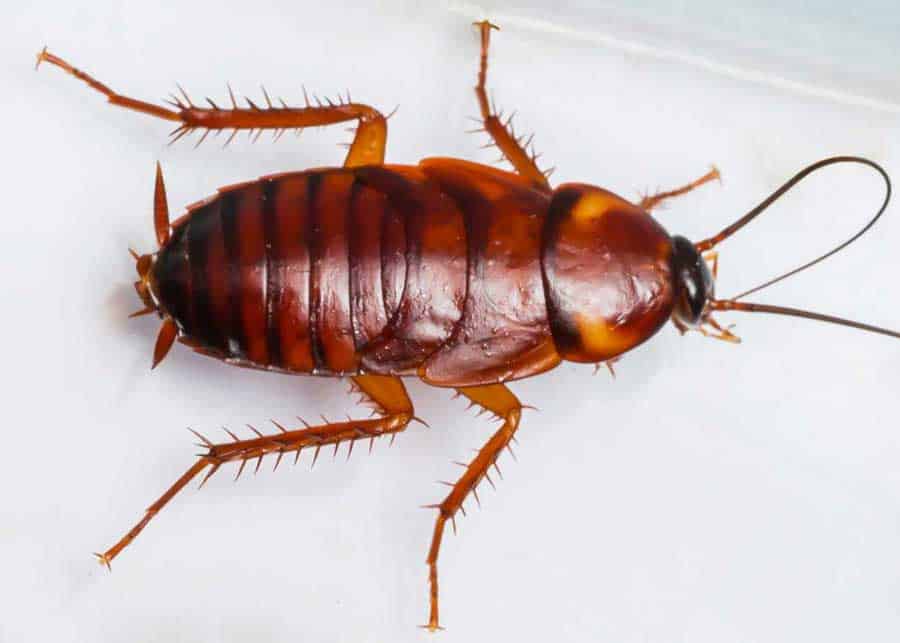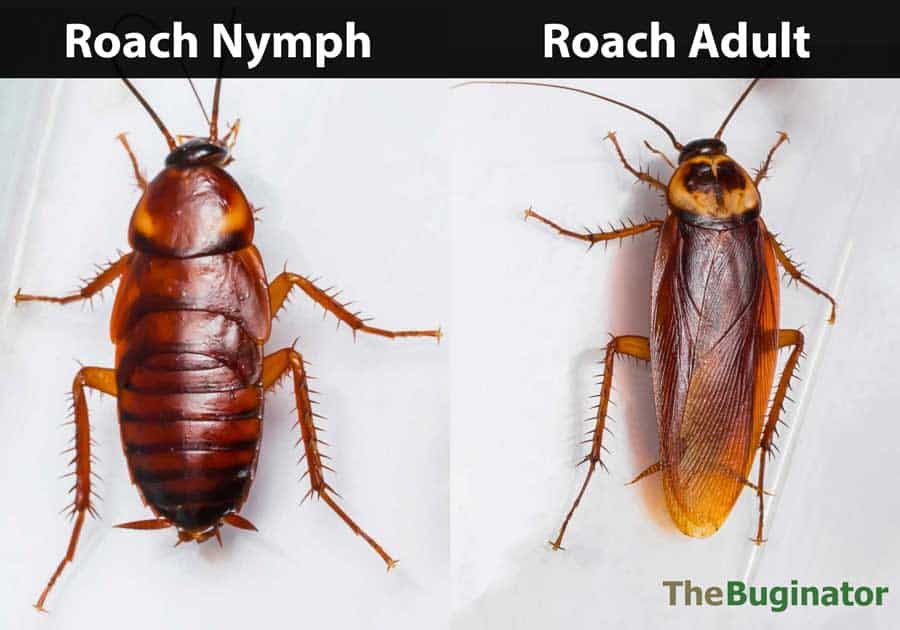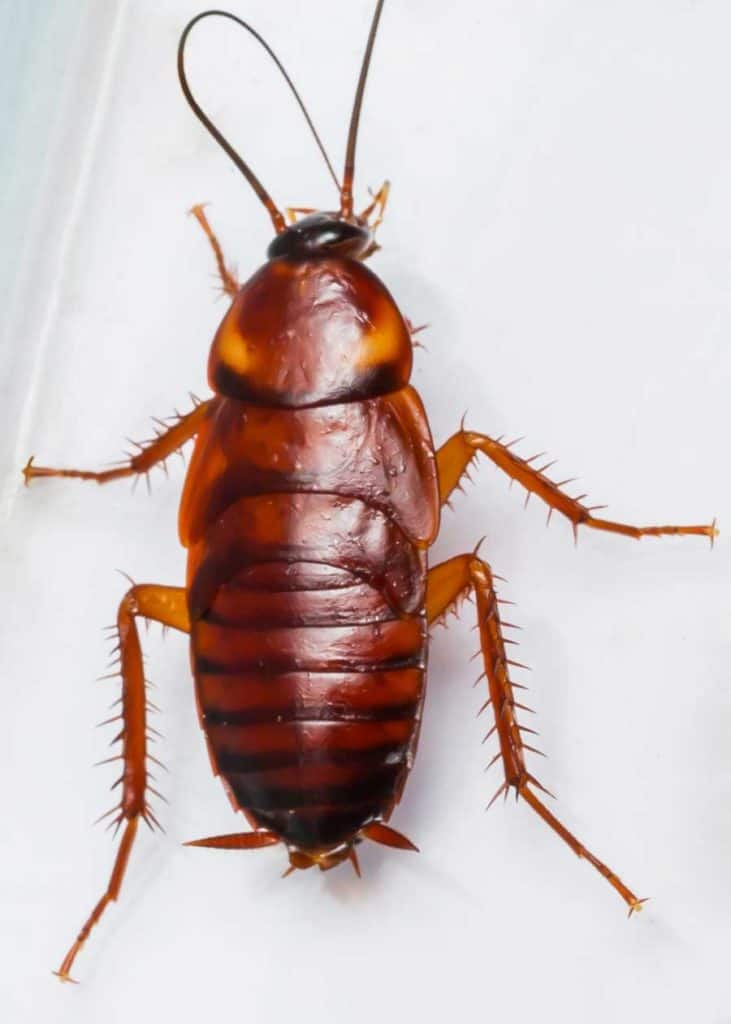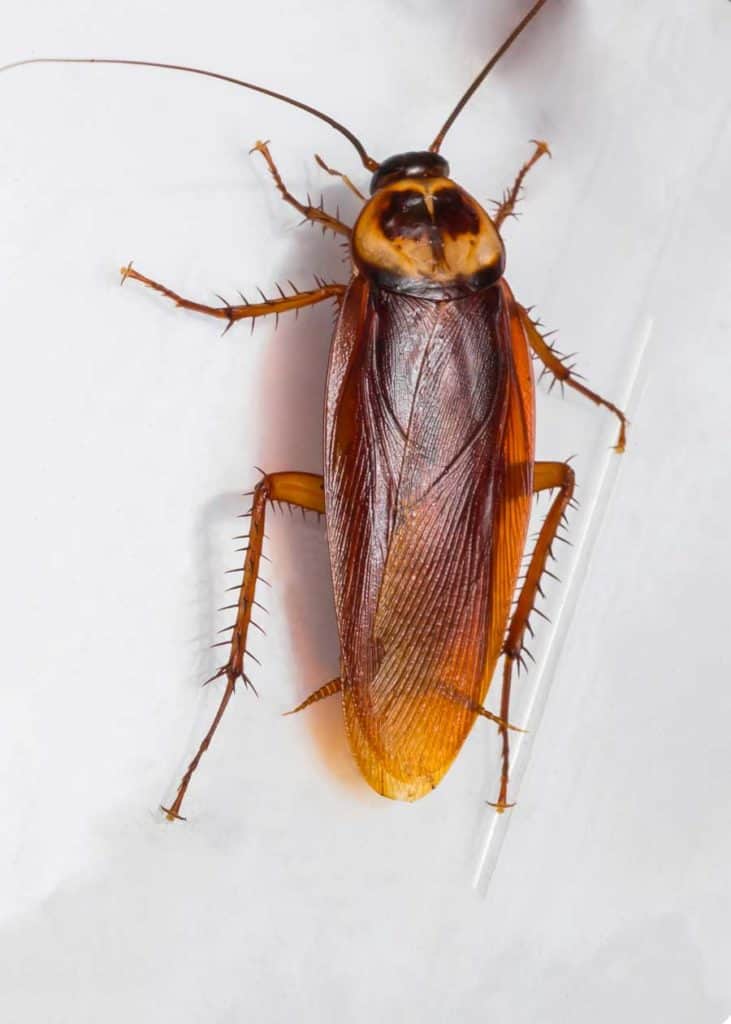Did you just see a baby roach? They have a distinct appearance to mature cockroaches. In this post, you’ll learn the six key features of baby cockroaches. These include lack of wings, beetle-like appearance, small cerci, different coloring, and smaller size.
Keep on reading to find out more about these tiny roaches. Comparison photos will help identify the differences between roach nymphs and mature roaches.

Baby cockroaches are hardy bugs found in almost every environment. Left unchecked, this tiny insect can quickly grow and reproduce. If you’ve seen a small roach recently, it may have been a baby cockroach.
Table of Contents
What Does a Baby Cockroach Look Like?
All roaches are insects, which means they each have the same insect anatomy. Baby roaches emerge with six legs and two antennae. The body of a baby roach has three distinct segments, the head, thorax, and abdomen.
Here are six features to identify a baby cockroach.
6 Baby Roach Features
- No visible wings. Many roaches develop wings as adults. But nymphs don’t have wings.
- Appearance similar to a beetle. The lack of wings makes the roach baby look more like a beetle than a cockroach.
- Larger head than adults. This is especially noticeable with young (recently hatched) nymphs. As they grow, the proportions begin to even out.
- Tiny cerci: On baby roaches, these tiny anal appendages are shorter than on adult cockroaches. More on cerci below.
- Coloring: Baby nymphs typically have different colors and shades than adults of the same species. Freshly hatched roach babies are often bright white.
- Size: It probably goes without saying that baby roaches are smaller than adults. And while this difference is dramatic at first, the nymphs quickly grow to be similar in size to the adults. If you see a large roach, you’ll need to consider the other features on this list to determine if it is a baby or an adult.
Some species of roaches are capable of flight. These species are born with underdeveloped wings. As the roach ages, its wings will lengthen and become functional.
What Are Cerci on Roaches?
Anal cerci are abdominal nerve ganglia. They are a pair of appendages located at the end of the abdomen and function as a secondary brain. They detect vibrations and are wind sensitive. Anal cerci is an essential sense organ present in both male and female cockroaches.
You can see the cerci in the photos below. They are noticeably shorter on the nymph.
Note: the photos are not to scale. This nymph is actually slightly smaller than the adult cockroach.

When a baby roach first hatches from the egg, it is a translucent white color.
As the exoskeleton solidifies, the color begins to change. Over a matter of hours, the outer shell of the baby roach will darken.
Different species of baby roaches will have specific coloring.
- The invasive German Cockroach is a darker brown as a baby than as an adult.
- American roaches start beige with brown on the lower abdomen and become fully dark brown in adulthood.
- The Oriental roach begins life with a reddish hue and develops into a mixed red-brown color as they age.
Here are photos of a roach nymph and then a roach adult.


Baby Roach Size
Like baby roach coloring, young roaches vary in size depending on their species.
- The most common large roach, the American Cockroach, hatches at around 8 mm in length.
- Baby oriental roaches are close to a quarter of an inch long.
American and Oriental roaches emerge from the egg at nearly the same size and develop at a similar rate. In adulthood, they range from 1 to 2 inches long.
- Baby German roaches are around an eighth of an inch long.
- Their small counterparts, Brown Banded Cockroaches, are a similar length. These two species reach adulthood when they’re about half of an inch.
German and Brown Banded Roaches are often mistaken as young cockroaches due to their small size.
One way to tell the difference between a young roach and a fully grown German roach is to look at the wings. Adult German roaches are small, but they have fully developed wings. An adolescent or baby roach will not have a complete set of wings.
Facts About Baby Cockroaches
A baby cockroach is known as a nymph
Roaches stay in the nymph stage until they reach their final size as adults. Adult cockroaches range in size depending on the species.
- American cockroaches are the largest at an intimidating 3 inches in length.
- German roaches are much smaller, reaching their adult size at about ½ of an inch.
Roaches do not lay one singular egg. Instead, they lay an egg case that contains anywhere from 16 to 50 eggs in each case. These egg cases are called oothecae. All roach species lay their eggs within an ootheca. If you’ve found a baby roach or an ootheca, it likely means more roaches are lurking around.
Once a baby roach emerges from the egg, it begins its hunt for food. Until a roach reaches sexual maturity, its life revolves around seeking out food and water sources. Most roaches reach maturity at about 6 to 12 months of age.
Once a baby cockroach hatches, it is a solitary bug.
Roaches are not social insects, no matter their age. A bad infestation may make you think that baby roaches like to group. Baby roaches are only found in groups when they gather around food, water, or shelter sources.
Diet of Baby Roaches
Baby roaches will eat anything and everything. Their diet is the same as adult roaches. The favorite food source of most roaches is food scraps or crumbs left behind by humans. Roaches aren’t picky animals.
A roach will eat anything remotely edible. Some like to feed on rotting wood. Others will target fresh vegetation. If there are roaches in your home, they will consume toothpaste, soap, and even wallpaper glue.
Keeping a tidy home is necessary because the diet of a roach is so diverse.
Left behind food or toothpaste in the sink could attract bugs within hours. If a consistent food source is available for cockroaches, they will stay close by and reproduce quickly.
Ideal Habitat of Baby Roaches
The truth about roaches is that they can live almost anywhere. You may have heard the old trope that cockroaches would survive nuclear fallout. While this isn’t exactly true, they are masters of survival. A roach can survive in extreme situations, doesn’t mean they prefer it.
Most species of roaches are attracted to a warm and wet habitat.
High-humidity areas are a perfect breeding ground. The warm weather and high humidity usually result in ample food access. Warm and wet environments lead to all kinds of rot, which roaches love.
Like most insects, roaches are not partial to the cold weather. You may notice more roach sightings inside during the winter months than usual. Roaches will seek shelter in warm homes during the colder months when it’s inhospitable outside.
Lifecycle of A Roach
Around one week after mating, roaches will lay their eggs inside of an ootheca.
Baby roaches will emerge from the eggs inside of the ootheca after about one month. When the eggs hatch inside the ootheca, the collective breathing of the baby roaches will cause the case to open.
Baby roaches come out of the egg as soft-shelled nymphs.
Over a matter of hours, their exoskeleton hardens, and the newly born nymph roaches are on their way.
Roaches remain in the nymph stage of life for 6 to 12 months. During the nymph stage of their lives, roaches will molt about six times. Molting means that the roach will shed its exoskeleton as they outgrow it. Underneath will be a newly formed and slightly larger exoskeleton.
Female roaches will lay between 6 to 14 batches of eggs throughout their lifetime. Both male and female roaches live for around a year on average.
How Long to Cockroaches Live: Lifespan of 4 Types
Your Turn
Baby roaches are industrious little bugs that can survive almost anywhere. They feed off of anything edible they can find. Most baby roaches prefer a warm and humid place to live.
The life cycle of a roach is not long but can lead to many more generations of new roaches being born. If you think you may have a problem with roaches in your home, act quickly. The speed with which roaches reproduce can lead to an infestation.
Have you found baby roaches in your home? How are you planning on handling this?
- About the Author
- Latest Posts
Bryan Haines is a co-founder and writer at The Buginator. And is working to make it the best resource for taking back the outdoors from biting, stinging pests.
He also blogs about travel at Storyteller.Travel and photography at Storyteller Tech. Bryan is a partner at Storyteller Media, a publishing company he runs with his wife, Dena.
